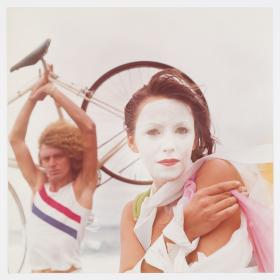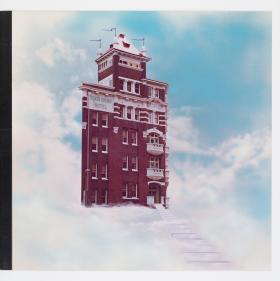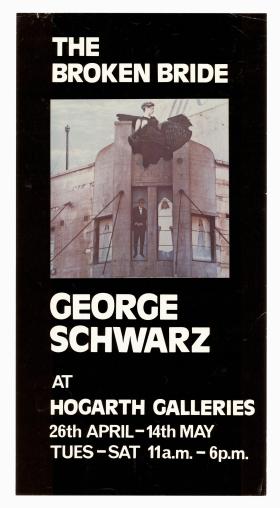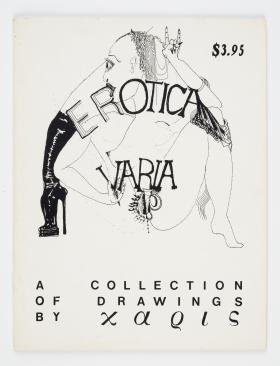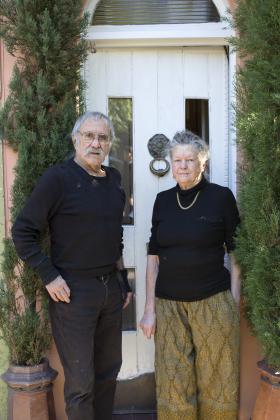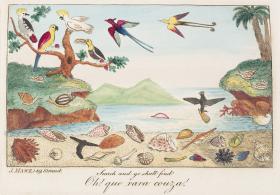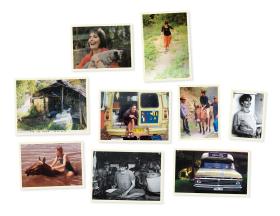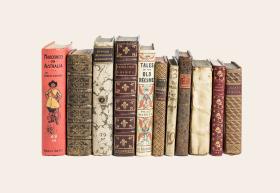George and Charis Schwarz are outliers in Australian art. In fact, even mentioning them in the context of ‘Australian art’ at all feels awkward. You won’t find the Schwarzes in the annals of the nation’s art history, critical responses to their work are close to non-existent, and no legacy-defining retrospective or survey exhibition has been held. Embraced by neither establishment nor academy, George and Charis are an art movement unto themselves — and they would not have had it any other way.
For those who know their work, the couple’s experimental and adventurous montage-based works are deeply significant. It’s also fair to say they are a unique Sydney cultural phenomenon, representing and defining an aesthetic and artistic philosophy, a long-gone bohemian era, and an impassioned devotion to the once-electric and colourful, now-gentrified, innereastern suburbs and its community.
First and foremost, though, they are artists. ‘To me everything else doesn’t matter, all I want to do is make art,’ says George, repeating one of his familiar mantras. ‘I hope that the day I die I’ll be in the middle of a work.’
Their output has been wildly diverse. The Schwarzes’ collaboration, from the late 1960s onwards, yielded avantgarde films, photography, mixed-media works, collages, one-off artist books and, as featured among the State Library of NSW’s new acquisitions, scripts, librettos and unpublished novels. Threaded through much of their work is a colourful abstract expressiveness, as well as a deep eroticism that manifests as a playful, fantastical presence — and some of it is graphic even by today’s standards.
‘It’s not pervy and it’s not pornography, it’s fun,’ says George as he sits with Charis in the parlour of their terraced Darlinghurst house. Their home since 1974 feels like a cross between a Spanish trogladita cave home and a museum, such is the range of curios, found objects and artworks that decorate it. Behind him hangs a striking series of framed photographs, showing closeups of both male and female genitalia, the former in imposing states of saluting excitement. ‘That’s what we call the family portraits,’ he says.
Ernst George Schwarz was born in 1935 and grew up in Zurich, Switzerland. After art school in Vevey he moved to Basel where he set up an antique shop and embarked on life as an artist. Eventually, he was attracted to the warm weather and cheap living of southern Spain. There, as a close friend of the couple, artist and curator Craig Judd, puts it, he ‘built his own villa in the side of a cliff, hunted with gypsies and grew his own food’.
It was on the beach in the town of Almayate that George met Charis McKittrick in 1964. Four years his junior, Charis, from Melbourne, was holidaying in Spain after travelling to London to study nursing. The chemistry between them was instant, intense and physical; Charis describes their early relationship as ‘a compulsion going on that I couldn’t control’.
Before long they wanted to travel to Australia — partly so Charis’s father, a clergyman, could marry them. This decision precipitated a key chapter in the Schwarz love story: an overland journey on a BMW R50 motorbike, through several exotic, often unmapped, regions: Iran, Iraq, Pakistan, Syria, India …
‘We had three dollars a day for food, petrol and overnight stays,’ says George. ‘We slept outside, ate the cheapest we could, and travelled through countries you couldn’t go through today.’
After marrying in Melbourne, further travels took them through Europe and North Africa, across to Canada and down through North and South America to Buenos Aires. Eventually they settled in Sydney, first on Victoria Street in Potts Point and then at the labyrinthine, catawampus Riley Street home in which they still dwell. Over the years there have been myriad films, photographic suites, hybrid art projects, collaborations, exhibitions, controversies and experiments. George and Charis made no fewer than nine self-funded films between 1968 and 1978, including the fabled Sex Aids and How to Use Them (the title can be taken as a literal indication of the film’s content) of 1975, which at the time became the highest-grossing Australian short film ever made.
To look over the Schwarz artworks and texts is to be dazzled, bewildered and moved. The label ‘surrealism’ might reasonably come to mind, were it not for the fact George rejects the term in relation to their work. ‘I can’t back the manifesto of the surrealists,’ says George. ‘Surrealism came out of revolt against society.’ Judd traces the couple’s art back to the Art Informel movement popular in postwar Europe and its close relation, Tachisme. Both styles embrace abstraction, non-geometric patterns and shapes and spontaneity.
Other influences include Belgian artists René Magritte and Paul Delvaux; Pieter Bruegel the Elder, whose work George saw in Zurich museums as a child; Salvador Dali; and a shared interest in French symbolist poetry. Australian art never made a great impression on the Schwarzes, though George talks of an admiration of Ian Fairweather and Jeffrey Smart. ‘Our lives have been quite separate to the artistic community,’ says Charis.
In fact, in the 1970s George wanted to create a brandnew visual mode of expression informed by both their travels and his new life in a strange country. ‘George was attracted to photography because it was a new language,’ says Judd. ‘He loved being an abstract artist, but the experience of riding around the world, and then being in the new world of Australia, required this new language.’
Perhaps George’s greatest inspiration of all, though, is Charis. When George speaks of his wife, a certain awe infuses his tone and language. And Judd, who is writing a book about the Schwarzes’ art, is keen to emphasise the pivotal role played by Charis in their creative life together.
‘They are very much equal in their partnership, and real collaborators,’ says Judd. ‘Charis is central to the development of all of this work. She was a sounding board, she helped organise everything, and when they first came back to Australia she was a translator.’
Judd also observes that George and Charis strived to ‘give the incredible lushness of films to the still photograph’. The Song Oblivion, 1972, for instance, is a never-exhibited series of staged photographs taken at Cronulla’s Wanda Beach, with accompanying text, or ‘songs’, by Charis. Certainly, there is a filmic quality to this theatrical but melancholy work, suggestive of narrative and an emotional arc.
Another item is The Broken Bride, 1977, an ornate bound book housed in an elegant chamois-lined black Perspex case. The book features 35 prints of beautiful, oneiric imagery, interspersed with 16 dyed-up clear cells or ‘overlays’. And again, the work is imbued with a cinematic sense of movement and duration, as people, objects, animals and iconography are playfully juxtaposed with each other. In a 1974 ABC television feature on her work, Charis spoke of her practice of ‘catching something out of the population and throwing it back, intensifying it’.
A further important aspect of The Broken Bride’s imagery is buildings and architecture that are immediately recognisable as ‘old’ Sydney. The prints show several Oxford Street facades that no longer exist. ‘George puts a jinx on a building,’ says Charis. ‘Everything he photographed happened to be demolished.’
And in true Schwarz fashion, the buildings are floating amid clouds, adorned with near-naked women or montaged with all manner of cross-cultural imagery. According to Judd, The Broken Bride represents the apogee of their exhibited work, given its technical innovation, its conceptual depth, its flavours of Sydney and the fact it was a collaboration with a silversmith, Roy Lewis, who made the case.
‘In the middle ages, monks would make decorative books,’ says George when asked about The Broken Bride, ‘and I wanted to make one like that.’
As for their more directly erotic works, the Library has also acquired The Veil, 1970, an album of photographs that features Charis as a model as well as the author of accompanying texts, and Erotica Varia, which Charis dubbed upon publication in 1973 as ‘the world’s first colouring-in book for adults.’
Interestingly, the couple at various points interacted with some illustrious and notorious figures of twentieth-century culture. In the 1970s they struck up a correspondence with Federico Fellini, who had plans to cast them in a film. In Paris, George was on waving terms with Simone de Beauvoir. He also knew the artist couple Niki de Saint Phalle and Jean Tinguely. He recalls General Franco visiting his village in Spain. In Australia, they were instrumental in the rise to popularity of Madame Lash (Gretel Pillinger) and may have been among the last people to see Juanita Nelson, the heiress and activist who was allegedly murdered in 1975, alive.
And then there are their activities beyond art-making: they are well-known social activists who have fought for various community causes over the decades; and they were nicknamed the ‘farmers of Darlinghurst’ for their beekeeping and award-winning honey and mead. George taught at the Sydney College of Fine Arts for 25 years; Charis spent many years working as a nurse.
But at the core of their lives is art. And, with George and Charis well into their eighties, now is the optimal time to consider their body of work, their importance, and their legacy.
‘The work of George and Charis was uniquely different to the familiar canons of Australian art and photography of the time,’ says Judd. ‘Their eye is distinct in its interest in a particular kind of storytelling, of identity, of a life in art.’
The Australian canon has forever been enriched by the contributions from George and Charis Schwarz, two people who are as profoundly inspiring in person as their art is compelling. And in its melding of cultures, techniques, mediums and philosophies, not to mention the lashings of sensuality, their work is in many ways the most exciting version of what Australian art can be.
Barnaby Smith is an arts writer, poet and musician who lives in the Blue Mountains.

